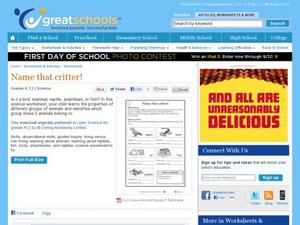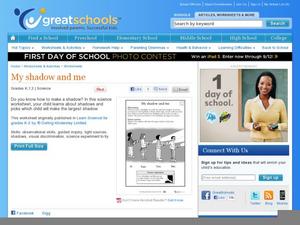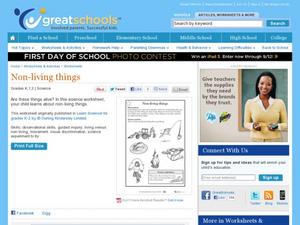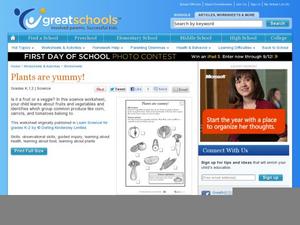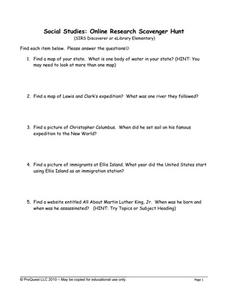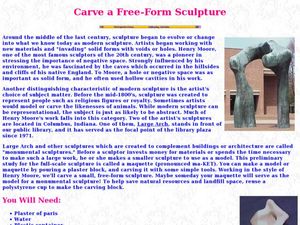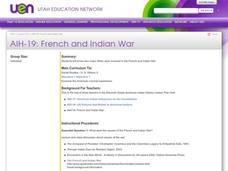Curated OER
Name That Critter
Young learners classify five different animals into their proper category. The animals pictured are a pigeon, a lizard, a cat, a frog, and a goldfish. Pupils are also asked to tell why they know it's a certain kind of animal. An...
Curated OER
My Shadow and Me
Practice making shadows with a kindergarten science experiment. After deciding which picture would represent the biggest shadow, kids use a flashlight to experiment with their own shadows. For extra fun, have kids mark their shadows...
Curated OER
Plants have needs, too!
Plants can die if they don't get enough sunlight and water. Kindergartners observe a picture of a hanging plant and grass under a tree, and interpret which each plant has died. Next, they grow watercress seeds in wet cotton to compare...
Curated OER
Ring-A-Ding-Ding!
What sound does metal make when you hit it? Kindergartners and first graders conduct an experiment about the properties of metal. First, they draw a line between metal items and descriptions of each. Next, they use a magnet to see which...
Curated OER
Georgia Vocabulary
In this Georgia activity, students match vocabulary words having to do with Georgia's famous people, places, and history to sentences that describe them. Students match 10 words.
Curated OER
Food for thought
Cake has to be good for something, right? Different foods are used by our bodies in different ways. Learners will first read about what fats, proteins, fruits, and vegetables do for the human body. They will then put each of food shown...
Curated OER
Magnets are forceful
You could use this worksheet two different ways. As is, or you could have learners actually do the experiment shown. They are to determine which magnet is strongest by counting the number of paper clips hanging from it. Why not get five...
Curated OER
Non-living Things
Very young scientists circle the things on the worksheet that they think are living things. Most of the pictures are of non-living things. A handy worksheet to use during any initial discussion about living vs. non-living things.
Curated OER
Plants are yummy!
Is it a fruit or a vegetable? Youngsters place an F next to each fruit they see and a V next to the vegetables. Corn is tricky. It is a grass, so it's actually not a fruit or a vegetable, but a grain!
Curated OER
Jetta vs. Corvette
In this secondary mathematics worksheet, students must determine which of two cars arrives in Cincinnati first. The information about one car is given in terms of distance and information on the other is in terms of time. The one page...
Curated OER
Time (Prepositions)
In this grammar worksheet, students choose the appropriate preposition in parentheses that makes twenty sentences grammatically correct.
Curated OER
Short Vowel U: Circle and Print #2
In this short vowel u worksheet, students circle the word in a pair that has the short u sound, then practice printing the word on a line beneath. A reference web site is given for additional activities.
Curated OER
Exploration of the Americas
Third graders demonstrate knowledge of exploration by naming and describing accomplishments of explorers. They use the internet to find corresponding information on the explorer and fill in a chart that is provided. Students also...
Odyssey of the Mind
Odyssey of the Mind Curriculum Activity: Balance the Books
There is a difference between profit and revenue, and it's up to your class to find out why. They each research the public accounting documents for their favorite company or brand. Then they use their findings to discuss the differences...
Curated OER
Who Led the South?
Eighth graders explore the role of Jefferson Davis and his leadership of the Confederacy during the Civil War. They examine the command system used in the Confederacy and analyze the effectiveness of the command system.
Curated OER
In the News
Fourth graders will use AlphaSmarts/Neos to create a one page newspaper in Word which features an early explorer. This lesson can be done entirely in the classroom. The students will perform research about the explorer prior to the...
Curated OER
Tic Tac Lesson: Learning About America
General information about America is covered in this presentation. There are 4 topical slides, our capital, important places, important people and our country's holidays. This PowerPoint would be a great discussion starter or as...
Curated OER
A Trip To Outer Space: Planet Exchange
Students examine the different planets in outer space. Each class studies a different planet and creates a scavenger hunt for the other classes to explore that planet.
Alabama Learning Exchange
Exploring Explorers
Students gather information about a 15th to 17th century explorer and prepare a script in talk show format about the individual. Finally, students make a video following the script and present it to the class.
Curated OER
Jackie Steals Home
Students read articles relating to Jackie Robinson's breaking of the racial barrier in professional baseball. This leads to a deeper exploration of racism in the United States. They use a variety of worksheets imbedded in this plan to...
Curated OER
Carve a Free-Form Sculpture
Students construct a free-from sculpture. In this sculpting lesson, students use plaster of paris, a malt cup, and finishing tools to create a sculpture. Students share their finished art pieces.
Curated OER
Stories That Go with the Territory
Students investigate various expeditions throughout history to new and/or uncharted territories. They work in groups to develop and 'produce' television news magazine segments about some of these historic expeditions.
Curated OER
French and Indian War
Eleventh graders examine why major tribes were involved in the French and Indian War. They write a short paragraph about the causes and answer an essay question based on text and Internet research, citing sources. They research text...
Curated OER
The Mystery of Exploration
Students comprehend the history of European exploration of North America. They are introduced to basic reasearch techniques. Students focus on four explorers who visited New York State: Verrazano, Cartier, Champlian, and Hudson. They...


